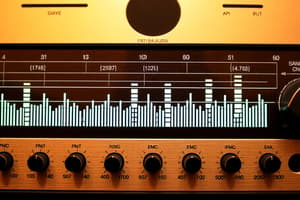Podcast
Questions and Answers
How is an analogue sound wave converted into a binary sample?
How is an analogue sound wave converted into a binary sample?
An analogue sound wave is converted into a binary sample by measuring the amplitude of the wave at specific intervals and recording these measurements in binary format.
What are two effects on an audio file when the sample rate is increased?
What are two effects on an audio file when the sample rate is increased?
Increasing the sample rate leads to higher audio quality and larger file sizes due to more data being captured for each sample.
What are two effects on an audio file when the bit depth is increased?
What are two effects on an audio file when the bit depth is increased?
Increasing the bit depth results in higher audio quality and larger file sizes, as more bits are available to represent each sample.
Calculate the file size in bytes for an audio sample with a bit depth of 8, a sample rate of 10, and duration of 12 seconds.
Calculate the file size in bytes for an audio sample with a bit depth of 8, a sample rate of 10, and duration of 12 seconds.
How does a higher sample rate affect the resemblance to the original analogue wave?
How does a higher sample rate affect the resemblance to the original analogue wave?
Why is a low sample rate considered to produce low-quality sound?
Why is a low sample rate considered to produce low-quality sound?
Explain why a higher bit depth contributes to better audio quality.
Explain why a higher bit depth contributes to better audio quality.
What is the trade-off when using a higher sample rate or bit depth in audio recording?
What is the trade-off when using a higher sample rate or bit depth in audio recording?
Flashcards
Sample Rate (Sampling Frequency)
Sample Rate (Sampling Frequency)
The number of times per second that the amplitude of an analog sound wave is measured during digital conversion. It determines how closely the digital representation resembles the original analog wave.
Bit Depth
Bit Depth
The number of bits used to represent the amplitude of each sample in a digital sound recording. It determines the dynamic range and overall detail of the audio.
Analog-to-Digital Conversion
Analog-to-Digital Conversion
The process of converting analog sound waves into digital data by measuring the amplitude of the wave at regular intervals.
Effect of Increasing Sample Rate
Effect of Increasing Sample Rate
Signup and view all the flashcards
Effect of Increasing Bit Depth
Effect of Increasing Bit Depth
Signup and view all the flashcards
Dynamic Range
Dynamic Range
Signup and view all the flashcards
Audio Fidelity
Audio Fidelity
Signup and view all the flashcards
File Size and Sample Rate/Bit Depth
File Size and Sample Rate/Bit Depth
Signup and view all the flashcards
Study Notes
Analogue to Digital Sound Conversion
- Analogue sound waves are converted into digital format by measuring their amplitude at specific intervals (samples).
- These measurements are recorded in binary code.
- Higher sample rates (measured in kHz) lead to more accurate representations of the original analogue wave, thus higher audio quality, but larger file sizes.
- Lower sample rates result in poorer quality as the digital representation doesn't closely match the original analogue wave.
Sample Rate Impact
- Increased sample rate means more samples per second, leading to a higher-fidelity digital representation.
- Higher sample rates result in larger file sizes due to the increased data for each sample.
Bit Depth Impact
- Higher bit depth means more bits available to represent each sample's value.
- Increased bit depth results in higher quality audio as more data accurately represents the original analog wave.
- Higher bit depth leads to larger file sizes because more bits are stored per sample.
File Size Calculation Example
- Bit depth of 8, sample rate of 10 samples/second, and a duration of 12 seconds:
- Total samples = (10 samples/second) * (12 seconds) = 120 samples
- Total bits per sample = 8 bits
- Total bits for the entire file = 120 samples * 8 bits/sample = 960 bits
- Total bytes = 960 bits / 8 bits/byte = 120 bytes
Studying That Suits You
Use AI to generate personalized quizzes and flashcards to suit your learning preferences.




